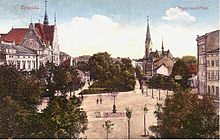- Duchy of Troppau
-
Duchy of Troppau
Ducatus Oppaviensis (la)
Opavské vévodství (cs)
Herzogtum Troppau (de)
Księstwo Opawskie (pl)Fiefdom of the Bohemian Crown ← 
1269–1918  →
→Coat of arms
Silesia 1249-1273: Duchy of Opava under Nicholas I in turquoise Capital Opava (Troppau) Government Principality Historical era Middle Ages - Partitioned from Moravia 1269 - Partitioned from Racibórz 1377 - Further partitions 1424, 1433 and 1452 - Directly to Bohemia 1462 - Northern part to Prussia 1742 - abolished 1918 The Principality or Duchy of Troppau or Opava (German: Herzogtum Troppau, Czech: Opavské vévodství or Opavské knížectví) was based for centuries around the Upper Silesian city of Troppau (Opava in modern day Czech Republic). In the final four centuries of its existence, the Duchy belonged to the Austrian Habsburg dynasty, and it was dissolved with the Habsburg Empire in 1918. However the title of Duke of Troppau and Jägerndorf still exists, as it belongs to a present day monarch, Hans-Adam II, Prince of Liechtenstein.
The duchy was created on lands split off from the March of Moravia before 1269[1] by King Ottokar II of Bohemia, to provide for his natural son, Nicholas I, Duke of Troppau, as he was known henceforth. Opava was thus not part of the original Polish Silesian province in 1138, and was first ruled by an illegitimate offshoot of the Bohemian House of Přemysl, not by the Silesian Piasts like many of the neighbouring Silesian duchies.
After the royal Přemyslid dynasty had become extinct, the House of Luxembourg ascended the Bohemian throne in 1310. In 1318, for Nicholas II Přemysl, the Duchy was confirmed as fief by King John of Bohemia[2], who soon had to fend off the Hungarian troops of Casimir III of Poland.[3] The conjunction with Silesia was accomplished when Duke Nicholas II married Anna of Racibórz, sister of the Piast Duke Leszek of Racibórz, also a Bohemian vassal since 1327. When Leszek died without heirs in 1336, King John vested his brother-in-law Nicholas II with the Silesian Duchy of Racibórz, whereafter he ruled both duchies in personal union until his death in 1365, when his eldest son John I succeeded him.
In 1377, Duke John I again separated Opava from the duchies of Racibórz and Krnov (Jägerndorf) and granted it to his younger brothers Nicholas III (†1394), Wenceslaus I (†1381) and Przemko (†1433). Hereinafter the Opava ownership changed several times, mainly by purchase and partitions. Przemko's sons finally sold their shares to the Bohemian king George of Poděbrady until 1462, their Přemyslid cousins however retained Racibórz (Ratibor) and Krnov (Jägerndorf). In 1465 King George gave Opava to his second son Victor, also Duke of Münsterberg since 1462. Victor in turn had to cede it to the Bohemian anti-king Matthias Corvinus in 1485, who installed his illegitimate son John as duke.
In 1506 King Vladislas II Jagiellon of Bohemia granted Opava to Duke Casimir II of Cieszyn (Teschen), who had married a daughter of Victor and held the duchy until his death in 1528 after which it was again seized by Bohemia. Meanwhile in 1521, with the death of Duke Valentin of Racibórz, the Opava line of the Přemyslids had finally become extinct and all their possessions had fallen back to the Bohemian Crown, which in 1526 passed to the Habsburg Monarchy. Prince Karl I of Liechtenstein[4] was in 1614 invested with the Duchy of Troppau by Emperor Matthias of Habsburg. After the 1620 Battle of White Mountain Prince Karl also acquired the Duchy of Krnov and ever since, the heads of the Princely Family of Liechtenstein bear the title Duke of Troppau and Jägerndorf.
In 1742, in the course of the First Silesian War and the Treaty of Breslau, the Duchy was divided once more, with the part north of Opava River including Głubczyce (Leobschütz) and Hlučín (Hultschin) becoming part of Prussia, the southern part with Krnov (Jägerndorf), Bruntál (Freudenthal), Fulnek and Opava itself remaining in Austrian Silesia, a crown land of the Austrian Empire from 1804.
The Austrian Duchy of Troppau ceased to exist when the Austro-Hungarian Empire was dissolved in 1918 and the area (Troppauer Land) including the city became part of Czechoslovakia. The Prussian share remained a part of the Silesian province until 1945, when it fell to Poland according to the Potsdam Agreement.
See also
Literature
- ^ [1]
- ^ Hans Ferdinand Helmolt: The World's History: A Survey of Man's Record, 1907, [2]
- ^ Geary, Patrick J.: Readings in Medieval History
- ^ Prince Karl I
- Seidl, Elmar: Das Troppauer Land zwischen den fünf Südgrenzen Schlesiens - Grundzüge der politischen und territorialen Geschichte bis zur Mitte des 19. Jahrhunderts. Berlin: Gebr. Mann. ISBN 3-7861-1626-1 [3]
External links
Duchies of Silesia 
Original 
Lower Silesia Upper Silesia Other Categories:- Former principalities
- Former countries in Europe
- States and territories established in 1269
- States and territories disestablished in 1918
- 1394 disestablishments
- Duchies of Silesia
- Historical regions in the Czech Republic
- 1918 disestablishments
Wikimedia Foundation. 2010.



